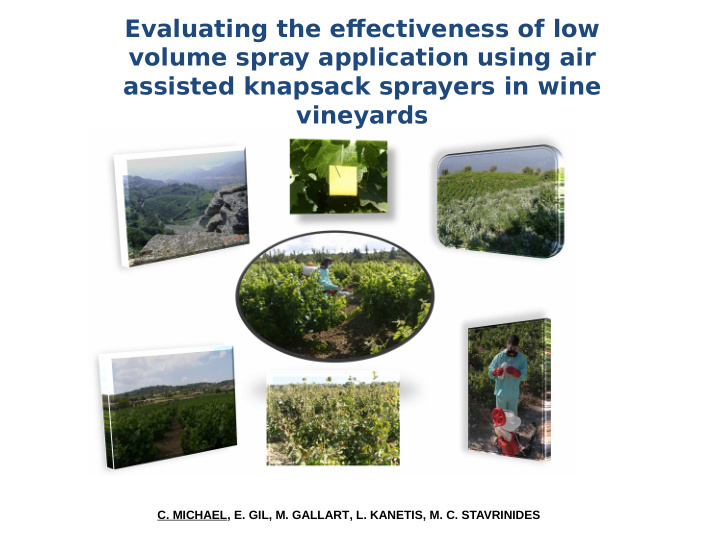



Evaluating the efgectiveness of low volume spray application using air assisted knapsack sprayers in wine vineyards C. MICHAEL, E. GIL, M. GALLARΤ, L. KANETIS, Μ. C. STAVRINIDES
Viticulture in Cyprus Is characterized by: Small plots (average size 0,6 ha) ≈ 7000 ha. Plots in mountains No irrigation system (85%) Lack of water (droughts) Dust formulation pesticides were banned from the market
Vineyards in mountains with no irrigation system available Κλάδος Προστασίας Φυτών Πάφου
Spray gun (hoses, high volumes) Κλάδος Προστασίας Φυτών Πάφου
Need assistance…! Κλάδος Προστασίας Φυτών Πάφου
Vineyards in steep slopes where a tractor cannot enter/work Κλάδος Προστασίας Φυτών Πάφου
Vineyards in steep slopes where a tractor cannot enter/work
European Directives & Regulations 2009/1107/ΕC (concerning the placing of plant protection products on the market) 2009/127/ΕU (machinery for pesticide application) 2009/128/ΕU (Sustainable Use of Pesticides)
Common practice (dusting sulphur) Κλάδος Προστασίας Φυτών Πάφου
Small particles of the dust formulations… Κλάδος Προστασίας Φυτών Πάφου
…could be carried by the wind up to 3 km Κλάδος Προστασίας Φυτών Πάφου
> 800 m Κλάδος Προστασίας Φυτών Πάφου
Air assisted motorized knapsack duster
Air assisted motorized knapsack duster
Alternative: Air assisted low volume knapsack sprayers
Study aim • Evaluate the efgectiveness of common, low volume and high volume sprayers in vineyards
Common Sprayer (CS)
Low Volume Sprayer (LVS)
High Volume Sprayer (HVS)
C= Control CS = Common Sprayer Field Trial LVS = Low Volume Sprayer HVS = High Volume Sprayer C LVS C HV S S C LVS C HV S S C HV C LVS S S C LVS HV C S S
Evaluation of coverage with Water Sensitive Papers
Evaluation of efgectiveness against grape berry moth ( Lobesia botrana ) and downy mildew ( Plasmopara viticola ) Grape Berry moth 3 bunches / vine Downy Mildew 10 leaves / vine
% coverage of WSP on leaves Coverage ≈ 20% CS ≈ 34% LVS ≈ 41% HVS • Sprayers ( F = 55.8, df = 3, 57, P < 0.001), Orientation ( F = 1.7, df = 1, 135, P = 0.20), Leaf position ( F = 0.06, df = 1, 135, P = 0.98)
% coverage of WSP on bunches % Mean Coverage ≈ 25% CS ≈ 42% LVS ≈ 45% HVS Signifjcant difgerences between the sprayers ( F = 16.9, df = 2, 42, P < 0.001) and orientation ( F = 13.69, df = 1, 45, P < 0.001), with a signifjcant interaction between sprayer and orientation ( F = 39.03, df = 2, 45, P < 0.001)
% infested berries per bunch • No signifjcant difgerences in berry infestation ( F = 0.74, df = 3, 142, P = 0.50). Mean infestation remained at around 10% . • The efgectiveness of spray applications depends among other factors on spray coverage, the pesticide active ingredients used, the presence of resistance in the target pest, and the timing of pesticide applications
Mean percentage area of leaf infected by downy mildew Signifjcant difgerences in leaf infection by downy mildew between treatments ( F = 5.6, df = 3, 189, P = 0.001). There was also a signifjcant efgect of application time ( F = 273.7, df = 6, 3140, P <0.001), and a signifjcant interaction between treatment and time ( F = 20.4, df = 18, 3140, P <0.001).
Conclusions LVS can achieve coverage of the spray material similar to that of HVS. Higher coverage with HVS rather than LVS was expected because of the higher volume of spray liquid applied with each sprayer, at 1400 L per hectare for HVS and 150 L for LVS. However, the difgerence in coverage between the two sprayers was not proportional to the difgerence in the amount of spray liquid used. For instance, overall mean coverage by HVS was around 50% for both leaves and bunches, while for LVS it ranged between ca. 40% for leaves and 45% for bunches. HVS LVS
Conclusions LVS are more environmentally friendly compared to HVS. HVS application resulted in substantial runofg. The excessive runofg of the spraying material from the outer leaves of the vine often misleads the farmers who consider that they fully and efgectively sprayed their vines. However, a relatively small amount of spraying liquid penetrates the foliage and reaches the grape bunches of the sprawl system. A high runofg of spraying liquid is not desirable, since there is a waste of spraying material and therefore economic loss for the producer and also soil pollution and subsequently of the groundwater through leaching.
Conclusions LVS are more environmentally friendly compared to HVS. No runofg was observed with the LVS, because most of the spraying liquid ended up on target. The presence of air at the LVS seems to play a signifjcant role to the dispersion and penetration of the liquid into the foliage.
Conclusions Adequate spray coverage can be achieved with volumes as low as 150 L/ha Determination of the pesticide dose based on the stage of plant growth and the surface of the leaf area (Barani et al., 2008; Gil et al., 2006) can lead to reduction of the quantity of pesticides applied and therefore the production cost without a corresponding compromise in the efgectiveness of sprays. Future work: Evaluate the coverage of air blast orchard sprayers in indigenous grape varieties of Cyprus
Recommend
More recommend